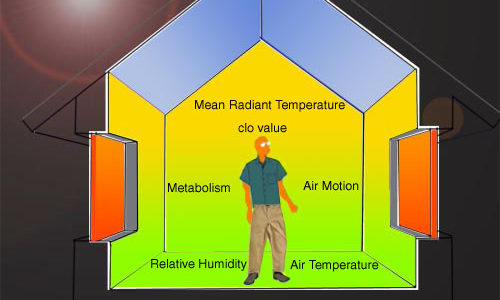Six Essential Comfort Tips for Home
Six Essential Comfort Tips for Home Heating, Cooling and Humidity in Alabama’s Mixed Humid Climate.
Don’t touch that dial on your home thermostat before asking, “Why is this room too hot, too cold or too Humid?”
The AlabamaWISE quick reference guide to maintaining affordable indoor comfort all year ‘round in Alabama’s mixed humid climate, based on six essential comfort elements.
Homes shelter our families from the hostile environment. In Alabama, that includes life threatening tornadoes and severe weather. Day in, day out we expect our homes to maintain healthy and comfortable indoor environment. However, even the newest home will only perform as well as it’s operated, so here is a short guide to the six essential components of indoor comfort to help you make informed decisions.

Six comfort values illustration from Arizona State University College of Architecture and Environmental Design
Air Temperature is often the only comfort metric monitored by your heating and cooling system. In most homes, a single thermostat is located in a central hallway to measure the “average” home temperature. Individual room temperatures can vary widely from the hall temperature, especially during summer and winter months. Room by room thermal comfort requires active management by the home occupant.
Relative Humidity is the biggest year-round comfort factor in Alabama’s mixed-humid climate. Even though outdoor air temperatures are often between 68 and 78 degrees – even during winter months, the high humidity is still a comfort problem. Most home heating and cooling systems do not monitor or automatically manage indoor humidity, so indoor humidity control also requires active management by the home occupants.
Air Movement creates a wind chill effect of cooling 4 to 6 degrees below room air temperature and helps the room feel less muggy, too. Energy star rated ceiling fans are the most effective energy-saving comfort system in any Alabama home. Ceiling fans are a room-by-room comfort system and every room should have one – even outdoor spaces like porches and breezeways. Ceiling fans require active management by home occupants.
Mean Radiant Temperature is a fancy name for the surface temperature of walls, ceiling and floor. Radiant temperatures can sometimes have a greater comfort than room air temperature. Who hasn’t experienced chilling discomfort from cold windows and floors or the comforting radiant heat of a blazing fireplace? Radiant comfort is mostly managed by insulation located in walls, attic and under the floor, but windows don’t insulate. Home occupants should use windows coverings to block summer heat from direct sunshine or to retain indoor heat on cold winter nights.
Clothing is the outdoor comfort system everyone understands and is an important part of indoor comfort, too. Clothing choices track the season because we need to leave the house for daily activity. Indoor comfort settings should account for seasonal clothing with cooler thermostat settings during the winter – usually 68 degrees and higher indoor summer settings – usually 78 degrees. Clothing adjustments are the easiest way to fine-tune personal indoor comfort.
Metabolism and Activity Level will vary widely from person to person and by activity. Is this the exercise room, TV room, kitchen or bedroom? Individual comfort levels vary too. Ever have disagreements with a spouse or roommate on where to set the thermostat?
Next time you’re uncomfortable indoors, consider all the options before adjusting the thermostat for better results – and you’ll probably save money on your utility bill, too. The bottom line is thermostat settings will only get you into the home comfort ballpark. Room by room comfort requires fine-tuning to your personal needs, room location and time of day.


Comments are closed.